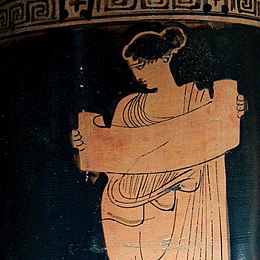This article may be too long to read and navigate comfortably. (September 2024) |
| Part of a series on |
| Reading |
|---|
 |
Reading is the process of taking in the sense or meaning of symbols, often specifically those of a written language, by means of sight or touch.[1][2][3][4]
For educators and researchers, reading is a multifaceted process involving such areas as word recognition, orthography (spelling), alphabetics, phonics, phonemic awareness, vocabulary, comprehension, fluency, and motivation.[5][6]
Other types of reading and writing, such as pictograms (e.g., a hazard symbol and an emoji), are not based on speech-based writing systems.[7] The common link is the interpretation of symbols to extract the meaning from the visual notations or tactile signals (as in the case of braille).[8]


- ^ "read". Merriam-Webster. 17 July 2023.
- ^ "Definition of 'read'". Collins English Dictionary.
- ^ "Read: Reproduce mentally or vocally the written or printed words by following the symbols with the eyes or fingers". The Concise Oxford Dictionary of Current English. The concise Oxford Dictionary. Oxford University Press. 1990. ISBN 0-19-861243-5.
- ^ "read". Cambridge Dictionary.
- ^ "What is reading? Reading Rockets". 24 April 2013.
- ^ "National reading panel, Teaching child to read, Reports of the subgroups" (PDF). 2000.
- ^ Joyce, Terry, Borgwaldt, S. (2013). Typology of Writing Systems. John Benjamins Publishing. p. 2. ISBN 978-90-272-0270-3.
- ^ "What Is Braille?". The American Foundation for the Blind.
- ^ Research evidence on reading for pleasure, Department for Education, England, DFE-57519-2012. 2012.